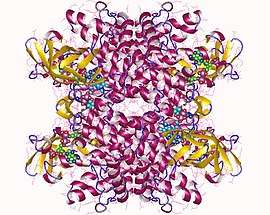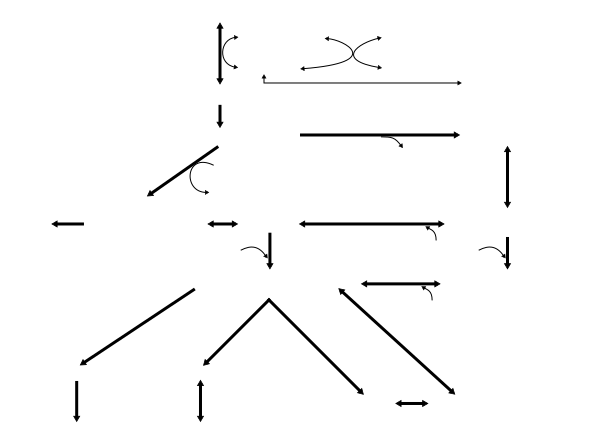Isovaleryl-CoA dehydrogenase
In enzymology, an isovaleryl-CoA dehydrogenase (EC 1.3.8.4) is an enzyme that catalyzes the chemical reaction
- 3-methylbutanoyl-CoA + acceptor 3-methylbut-2-enoyl-CoA + reduced acceptor
| isovaleryl-CoA dehydrogenase | |||||||||
|---|---|---|---|---|---|---|---|---|---|
 Isovaleryl-CoA dehydrogenase tetramer, Human | |||||||||
| Identifiers | |||||||||
| EC number | 1.3.8.4 | ||||||||
| CAS number | 37274-61-6 | ||||||||
| Databases | |||||||||
| IntEnz | IntEnz view | ||||||||
| BRENDA | BRENDA entry | ||||||||
| ExPASy | NiceZyme view | ||||||||
| KEGG | KEGG entry | ||||||||
| MetaCyc | metabolic pathway | ||||||||
| PRIAM | profile | ||||||||
| PDB structures | RCSB PDB PDBe PDBsum | ||||||||
| Gene Ontology | AmiGO / QuickGO | ||||||||
| |||||||||
Thus, the two substrates of this enzyme are 3-methylbutanoyl-CoA and acceptor, whereas its two products are 3-methylbut-2-enoyl-CoA and reduced acceptor.
This enzyme belongs to the family of oxidoreductases, specifically those acting on the CH-CH group of donor with other acceptors. The systematic name of this enzyme class is 3-methylbutanoyl-CoA:acceptor oxidoreductase. Other names in common use include isovaleryl-coenzyme A dehydrogenase, isovaleroyl-coenzyme A dehydrogenase, and 3-methylbutanoyl-CoA:(acceptor) oxidoreductase. This enzyme participates in valine, leucine and isoleucine degradation. It employs one cofactor, FAD.
Structural studies
As of late 2007, only one structure has been solved for this class of enzymes, with the PDB accession code 1IVH. It was created by a group containing K.A.Tiffany, D.L.Roberts, M.Wang, R.Paschke, A.-W.A.Mohsen, J.Vockley, and J.J.P.Kim. The structure was released on May 20th, 1998.Doe. "PDBsum entry: 1ivh". Retrieved November 25, 2019.
Leucine metabolism
References
- Wilson JM, Fitschen PJ, Campbell B, Wilson GJ, Zanchi N, Taylor L, Wilborn C, Kalman DS, Stout JR, Hoffman JR, Ziegenfuss TN, Lopez HL, Kreider RB, Smith-Ryan AE, Antonio J (February 2013). "International Society of Sports Nutrition Position Stand: beta-hydroxy-beta-methylbutyrate (HMB)". Journal of the International Society of Sports Nutrition. 10 (1): 6. doi:10.1186/1550-2783-10-6. PMC 3568064. PMID 23374455.
- Kohlmeier M (May 2015). "Leucine". Nutrient Metabolism: Structures, Functions, and Genes (2nd ed.). Academic Press. pp. 385–388. ISBN 978-0-12-387784-0. Retrieved 6 June 2016.
Energy fuel: Eventually, most Leu is broken down, providing about 6.0kcal/g. About 60% of ingested Leu is oxidized within a few hours ... Ketogenesis: A significant proportion (40% of an ingested dose) is converted into acetyl-CoA and thereby contributes to the synthesis of ketones, steroids, fatty acids, and other compounds
Figure 8.57: Metabolism of L-leucine
- BACHHAWAT BK, ROBINSON WG, COON MJ (1956). "Enzymatic carboxylation of beta-hydroxyisovaleryl coenzyme A". J. Biol. Chem. 219 (2): 539–50. PMID 13319276.
- Ikeda Y, Tanaka K (1983). "Purification and characterization of isovaleryl coenzyme A dehydrogenase from rat liver mitochondria". J. Biol. Chem. 258 (2): 1077–85. PMID 6401713.
- Tanaka K, Budd MA, Efron ML, Isselbacher KJ (1966). "Isovaleric acidemia: a new genetic defect of leucine metabolism". Proc. Natl. Acad. Sci. U.S.A. 56 (1): 236–42. doi:10.1073/pnas.56.1.236. PMC 285701. PMID 5229850.
